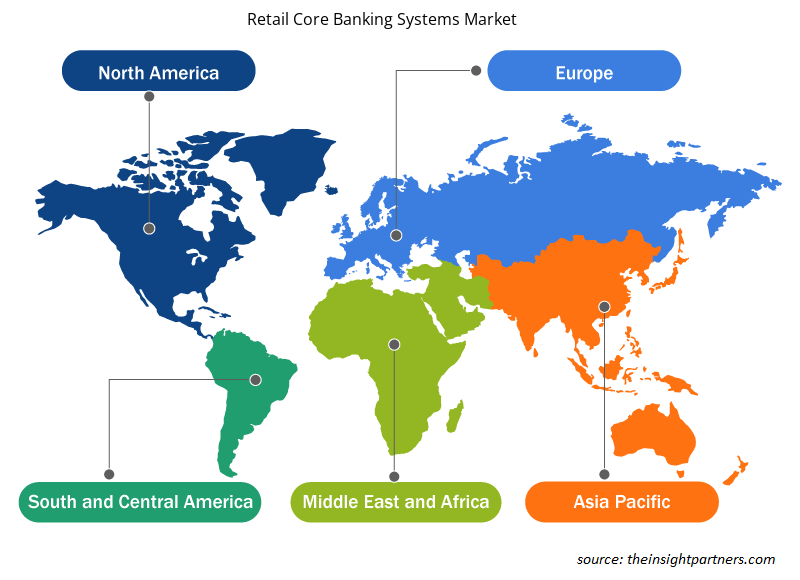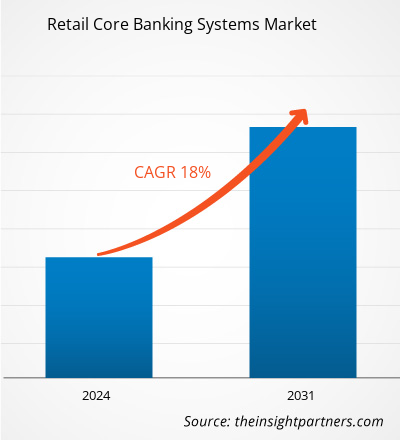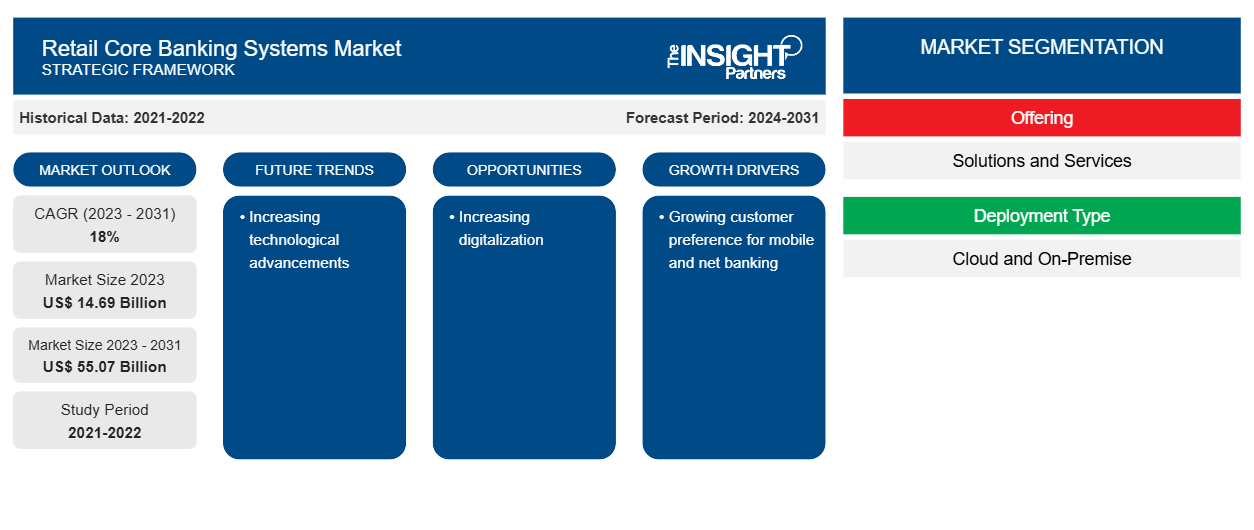소매 핵심 은행 시스템 시장 규모는 2023년 146억 9천만 달러에서 2031년까지 550억 7천만 달러에 도달할 것으로 예상됩니다. 이 시장은 2023~2031년에 18%의 CAGR을 기록할 것으로 예상됩니다.CAGR of 18% in 2023–2031. 기술의 발전이 소매 핵심 은행 시스템 시장 동향의 핵심이 될 가능성이 높습니다.
리테일 코어 뱅킹 시스템 시장 분석
은행 시스템이 최첨단 기술을 빠르게 도입함에 따라 소매 핵심 은행 솔루션에 대한 글로벌 시장이 크게 성장하고 있으며 앞으로도 그럴 것으로 예상됩니다. 핵심 은행 시스템은 고객이 다양한 금융 서비스에 액세스하고 전 세계 어디에서나 계좌를 확인할 수 있도록 하는 은행 지점 네트워크입니다.
또한, 은행과 FinTech 회사는 각자의 사업의 지속 가능성과 성장을 강화하기 위해 정보 기술(IT)을 적용하고 있습니다. 핵심 뱅킹 기술은 고객을 만족시키고, 은행 거래 성과를 향상시키고, 변화하는 사업 요구에 신속하게 적응할 수 있는 방법을 제공합니다. 또한 기술을 통해 은행은 프로세스를 간소화하고, 지연을 줄이고, 보고 및 규정 준수를 개선하고, 고객에게 간단한 액세스를 제공할 수 있습니다.FinTech companies to enhance the sustainability and growth of their respective businesses. Core
소매 핵심 은행 시스템 시장 개요
소매 핵심 뱅킹 시스템은 은행이 개인 또는 소비자 뱅킹을 위한 디지털 채널을 통해 고객에게 더 나은 서비스를 제공하는 데 필요한 도구를 제공합니다. 고객이 신용에 액세스하고 안전하게 돈을 옮길 수 있도록 함으로써 이러한 기술은 고객의 자금 관리를 개선합니다. 소매 뱅킹 시스템을 사용하면 은행이 저렴한 비용으로 자본을 조달하고 안정적인 고객을 확보하며 효과적인 고객 관계 관리(CRM)를 유지하는 데 도움이 되며, 이 모든 것이 소매 핵심 뱅킹 시스템 시장을 주도할 것으로 예상됩니다. 또한 모바일 및 넷 뱅킹에 대한 소비자 수요가 증가함에 따라 시장 확장이 지원되고 있습니다.
귀하의 요구 사항에 맞게 이 보고서를 사용자 정의하세요
이 보고서의 일부 또는 국가 수준 분석, Excel 데이터 팩을 포함하여 모든 보고서에 대한 사용자 정의를 무료로 받을 수 있으며 신생 기업 및 대학을 위한 훌륭한 혜택과 할인 혜택을 이용할 수 있습니다.
-
이 보고서의 주요 시장 동향을 알아보세요.이 무료 샘플에는 시장 동향부터 추정 및 예측까지 다양한 데이터 분석이 포함됩니다.
소매 핵심 은행 시스템 시장 동인 및 기회
모바일 및 넷뱅킹에 대한 고객 선호도 증가
리테일 코어 뱅킹 솔루션 시장의 미래 성장은 주로 모바일 및 넷 뱅킹에 대한 고객 수요 증가에 기인할 것입니다. 모바일 뱅킹의 도움으로 고객은 스마트폰이나 태블릿과 같은 휴대 기기를 사용하여 은행 계좌에 액세스하고 관리할 수 있으며 다른 금융 업무를 수행할 수 있습니다. "넷 뱅킹"이라고 알려진 뱅킹 서비스를 통해 사용자는 다양한 뱅킹 리소스에 액세스하고 인터넷을 통해 금융 거래를 수행할 수 있습니다. 보다 원활한 채널 운영을 보장하기 위해 리테일 코어 뱅킹 솔루션을 사용하여 넷 뱅킹 서비스를 은행의 기존 운영 채널과 연결합니다.
디지털화 증가
리테일 코어 뱅킹 솔루션 시장의 미래 성장은 주로 은행 산업의 디지털화 증가에 기인합니다. 은행, 금융 서비스 및 보험(BFSI) 부문에서 "디지털 혁신"은 디지털 기술과 전략을 통합하여 고객 경험을 개선하고, 비즈니스 프로세스를 간소화하고, 산업 경쟁력을 높이는 것을 의미합니다. 멀티채널 뱅킹은 리테일 코어 뱅킹 솔루션으로 지원되어 ATM, 모바일 앱 , 온라인 뱅킹 등 다양한 채널을 통해 사용자에게 서비스에 액세스할 수 있도록 합니다. 따라서 디지털화 증가는 예측 기간 동안 리테일 코어 뱅킹 시스템 시장 참여자에게 새로운 기회를 제공할 것으로 예상됩니다.
소매 핵심 은행 시스템 시장 보고서 세분화 분석
소매 핵심 은행 시스템 시장 분석에서 도출된 주요 세그먼트는 제공 유형과 배포 유형입니다.
제공(솔루션 및 서비스), 배포 유형(클라우드 및 온프레미스) 및 지역
- 제공되는 서비스에 따라 소매 핵심 뱅킹 시스템 시장은 솔루션과 서비스로 구분됩니다.
- 배포 유형별로 시장은 클라우드와 온프레미스로 세분화됩니다. 클라우드 세그먼트는 2023년에 시장에서 가장 큰 점유율을 차지했습니다.
지역별 리테일 코어 뱅킹 시스템 시장 점유율 분석
소매 핵심 은행 시스템 시장 보고서의 지리적 범위는 주로 북미, 아시아 태평양, 유럽, 중동 및 아프리카, 남미/남중부 아메리카의 5개 지역으로 나뉩니다. 수익 측면에서 북미는 가장 큰 소매 핵심 은행 시스템 시장 점유율을 차지했습니다. 핵심 은행 솔루션의 주요 지속적인 기술 발전과 Canadian Western Bank 및 HSBC Holdings plc와 같은 주요 회사의 채택으로 인해 지배력은 예상 기간 동안 지속될 것으로 예상됩니다.
소매 핵심 은행 시스템 시장 지역 통찰력
Insight Partners의 분석가들은 예측 기간 동안 리테일 코어 뱅킹 시스템 시장에 영향을 미치는 지역적 추세와 요인을 철저히 설명했습니다. 이 섹션에서는 북미, 유럽, 아시아 태평양, 중동 및 아프리카, 남미 및 중미의 리테일 코어 뱅킹 시스템 시장 세그먼트와 지리에 대해서도 설명합니다.

- 소매 핵심 은행 시스템 시장에 대한 지역별 데이터 얻기
소매 핵심 은행 시스템 시장 보고서 범위
| 보고서 속성 | 세부 |
|---|---|
| 2023년 시장 규모 | 146억 9천만 달러 |
| 2031년까지 시장 규모 | 550억 7천만 달러 |
| 글로벌 CAGR (2023-2031) | 18% |
| 역사적 데이터 | 2021-2022 |
| 예측 기간 | 2024-2031 |
| 다루는 세그먼트 |
제공함으로써
|
| 포함된 지역 및 국가 |
북아메리카
|
| 시장 선도 기업 및 주요 회사 프로필 |
|
시장 참여자 밀도: 비즈니스 역학에 미치는 영향 이해
소매 핵심 은행 시스템 시장 시장은 소비자 선호도의 변화, 기술 발전, 제품의 이점에 대한 인식 증가와 같은 요인으로 인해 최종 사용자 수요가 증가함에 따라 빠르게 성장하고 있습니다. 수요가 증가함에 따라 기업은 제품을 확장하고, 소비자의 요구를 충족하기 위해 혁신하고, 새로운 트렌드를 활용하여 시장 성장을 더욱 촉진하고 있습니다.
시장 참여자 밀도는 특정 시장이나 산업 내에서 운영되는 회사나 기업의 분포를 말합니다. 주어진 시장 공간에 얼마나 많은 경쟁자(시장 참여자)가 존재하는지 그 규모나 전체 시장 가치에 비해 나타냅니다.
소매 핵심 은행 시스템 시장에서 운영되는 주요 회사는 다음과 같습니다.
- 오라클 주식회사
- SAP SE
- 타타 컨설턴시 서비스 리미티드
- 피나스트라 인터내셔널 리미티드
- 자본은행 솔루션
- 에지버브 시스템즈 리미티드
면책 조항 : 위에 나열된 회사는 어떤 특별한 순서에 따라 순위가 매겨지지 않았습니다.

- 소매 핵심 은행 시스템 시장 주요 주요 업체 개요를 알아보세요
리테일 코어 뱅킹 시스템 시장 뉴스 및 최근 개발
소매 핵심 은행 시스템 시장은 1차 및 2차 연구 이후의 질적, 양적 데이터를 수집하여 평가합니다. 여기에는 중요한 기업 간행물, 협회 데이터 및 데이터베이스가 포함됩니다. 다음은 언어 장애 및 전략 시장에서의 개발 목록입니다.
- 2023년 4월, Oracle FS는 Oracle의 FLEXCUBE 구현 파트너인 Profinch와 협력하여 에티오피아에 본사를 둔 OMO Bank의 핵심 뱅킹 소프트웨어를 업데이트하고 새로운 자금세탁방지(AML) 및 사기 방지 기술을 통합했습니다.
(출처: 오라클, 보도자료)
- 2023년 10월, Sopra Banking Software(SBS)라는 핀테크 스타트업이 최첨단 SaaS(Software-as-a-Service) 핵심 뱅킹 플랫폼을 출시했습니다. 이 플랫폼은 실시간으로 작동하는 AI 지원, 완전 클라우드 네이티브 솔루션입니다.
소매 핵심 은행 시스템 시장 보고서 범위 및 제공물
"소매 핵심 은행 시스템 시장 규모 및 예측(2021-2031)" 보고서는 아래 영역을 포괄하는 시장에 대한 자세한 분석을 제공합니다.
- 범위에 포함된 모든 주요 시장 세그먼트에 대한 글로벌, 지역 및 국가 수준의 시장 규모 및 예측
- 동인, 제약 및 주요 기회와 같은 시장 역학
- 주요 미래 트렌드
- 자세한 PEST/포터의 5가지 힘과 SWOT 분석
- 주요 시장 동향, 주요 업체, 규정 및 최근 시장 동향을 포괄하는 글로벌 및 지역 시장 분석
- 시장 집중도, 히트맵 분석, 유명 기업 및 최근 개발 사항을 포함하는 산업 환경 및 경쟁 분석
- 자세한 회사 프로필
- 과거 분석(2년), 기준 연도, CAGR을 포함한 예측(7년)
- PEST 및 SWOT 분석
- 시장 규모 가치/거래량 - 글로벌, 지역, 국가
- 산업 및 경쟁 환경
- Excel 데이터세트
최근 보고서
사용 후기
구매 이유
- 정보에 기반한 의사 결정
- 시장 역학 이해
- 경쟁 분석
- 고객 인사이트
- 시장 예측
- 위험 완화
- 전략 기획
- 투자 타당성 분석
- 신흥 시장 파악
- 마케팅 전략 강화
- 운영 효율성 향상
- 규제 동향에 발맞춰 대응























 무료 샘플 받기 - 소매 핵심 은행 시스템 시장
무료 샘플 받기 - 소매 핵심 은행 시스템 시장